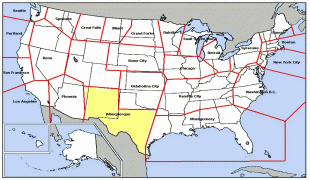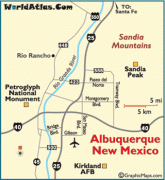Albuquerque (Albuquerque)
 |
 |
Located in the Albuquerque Basin, the city is flanked by the Sandia Mountains to the east and the West Mesa to the west, with the Rio Grande and bosque flowing north-to-south through the middle of the city. According to the 2020 census, Albuquerque had 564,559 residents, making it the 32nd-most populous city in the United States and the fourth largest in the Southwest. The Albuquerque metropolitan area had 916,528 residents in 2020, and forms part of the Albuquerque–Santa Fe–Las Vegas combined statistical area, which had a population of 1,162,523.
Albuquerque is a hub for technology and media companies, historic landmarks, and the fine arts. The city is home to the University of New Mexico, the Albuquerque International Balloon Fiesta, the Gathering of Nations, the New Mexico State Fair, as well as for its diverse restaurant scene, which features both New Mexican and global cuisine.
Petroglyphs carved into basalt in the western part of the city bear testimony to an early Native American presence in the area, now preserved in the Petroglyph National Monument.
The Tanoan and Keresan peoples had lived along the Rio Grande for centuries before European settlers arrived in what is now Albuquerque. By the 1500s, there were around 20 Tiwa pueblos along a 60 mi stretch of river from present-day Algodones to the Rio Puerco confluence south of Belen. Of these, 12 or 13 were densely clustered near present-day Bernalillo and the remainder were spread out to the south.
Two Tiwa pueblos lie specifically on the outskirts of the present-day city, both of which have been continuously inhabited for many centuries: Sandia Pueblo, which was founded in the 14th century, and the Pueblo of Isleta, for which written records go back to the early 17th century, when it was chosen as the site of the San Agustín de la Isleta Mission, a Catholic mission.
The Navajo, Apache, and Comanche peoples were also likely to have set camps in the Albuquerque area, as there is evidence of trade and cultural exchange among the different Native American groups going back centuries before European arrival. Albuquerque was founded in 1706 as an outpost as La Villa de Alburquerque by Francisco Cuervo y Valdés in the provincial kingdom of Santa Fe de Nuevo México and named after the Viceroy Francisco Fernández de la Cueva, 10th duke of Alburquerque, which is from a town in Spain. Albuquerque was a farming and shepherding community and strategically located trading and military outpost along the Camino Real, for the other already established for the Tiquex and Hispano towns in the area, such as Barelas, Corrales, Isleta Pueblo, Los Ranchos, and Sandia Pueblo.
After 1821, Mexico also had a military presence there. The town of Alburquerque was built in the traditional Spanish villa pattern: a central plaza surrounded by government buildings, homes, and a church. This central plaza area has been preserved and is open to the public as a cultural area and center of commerce. It is referred to as "Old Town Albuquerque" or simply "Old Town". Historically it was sometimes referred to as "La Placita" (Little Plaza in Spanish). On the north side of Old Town Plaza is San Felipe de Neri Church. Built in 1793, it is one of the oldest surviving buildings in the city.
After the New Mexico Territory became a part of the United States, Albuquerque had a federal garrison and quartermaster depot, the Post of Albuquerque, from 1846 to 1867. In Beyond the Mississippi (1867), Albert D. Richardson, traveling to California via coach, passed through Albuquerque in late October 1859—its population was 3,000 at the time—and described it as "one of the richest and pleasantest towns, with a Spanish cathedral and other buildings more than two hundred years old."
During the Civil War, Albuquerque was occupied for a month in February 1862 by Confederate troops under General Henry Hopkins Sibley, who soon afterwards advanced with his main body into northern New Mexico. During his retreat from Union troops into Texas, he made a stand on April 8, 1862 at Albuquerque and fought the Battle of Albuquerque against a detachment of Union soldiers commanded by Colonel Edward R. S. Canby. This daylong engagement at long range led to few casualties, as the citizens of Albuquerque aided the Republican Union to rid the city of the occupying Confederate troops.
Map - Albuquerque (Albuquerque)
Map
Country - United_States
 |
 |
| Flag of the United States | |
Indigenous peoples have inhabited the Americas for thousands of years. Beginning in 1607, British colonization led to the establishment of the Thirteen Colonies in what is now the Eastern United States. They quarreled with the British Crown over taxation and political representation, leading to the American Revolution and proceeding Revolutionary War. The United States declared independence on July 4, 1776, becoming the first nation-state founded on Enlightenment principles of unalienable natural rights, consent of the governed, and liberal democracy. The country began expanding across North America, spanning the continent by 1848. Sectional division surrounding slavery in the Southern United States led to the secession of the Confederate States of America, which fought the remaining states of the Union during the American Civil War (1861–1865). With the Union's victory and preservation, slavery was abolished nationally by the Thirteenth Amendment.
Currency / Language
| ISO | Currency | Symbol | Significant figures |
|---|---|---|---|
| USD | United States dollar | $ | 2 |
| ISO | Language |
|---|---|
| EN | English language |
| FR | French language |
| ES | Spanish language |

























